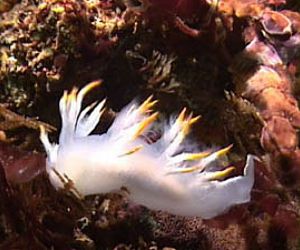
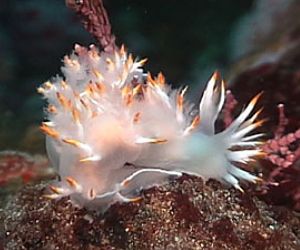
Dendronotus albus
Macfarland, 1966
Order: NUDIBRANCHIA
Suborder: DENDRONOTINA
Family: Dendronotidae
DISTRIBUTION
Alaska to Baja California.
PHOTO
Carmel Bay, California, in about 20M of water. Lower photo showing mating pair. Photo: Clinton Bauder
Similar to D. diversicolor in having an opaque white line on the 'tail' but it usually has more than four pairs of cerata (usually 5-7), and usually has the cerata tipped with orange-yellow, although in rare cases this colour is absent. D. diversicolor also has a white colour form but it usually has no more than 4 pairs of cerata.
Reference:
• Robilliard, G.A. (1970) The systematics and some aspects of the ecology of the genus Dendronotus (Gastropoda: Nudibranchia). The Veliger, 12(4): 433-479.
Rudman, W.B., 2001 (August 12) Dendronotus albus Macfarland, 1966. [In] Sea Slug Forum. Australian Museum, Sydney. Available from http://www.seaslugforum.net/find/dendalbu
Related messages
Dendronotus albus from Vancouver Island
September 24, 2007
From: Mark Lloyd
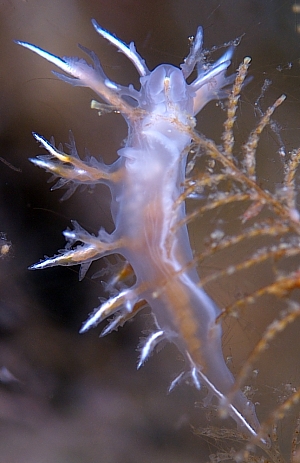
I thought everyone would appreciate this shot were you can clearly see the animal eating.
Locality: Hussar Point, Vancouver Island, 15m, BC, Canada, 26 August 2007, Ledge on wall. Length: 20mm. Photographer: Mark Lloyd.
Mark Lloyd
m_lloyd@yahoo.com
Lloyd, M., 2007 (Sep 24) Dendronotus albus from Vancouver Island. [Message in] Sea Slug Forum. Australian Museum, Sydney. Available from http://www.seaslugforum.net/find/20738Hi Mark,
This is truly a gorgeous shot. You can see a lot more that just the mouth grasping the thecate hydroid. Note also the genital apertures, with erected male organ, the digestive gland ramifying thoughtout the body and the exquisite detail of the "cerata." Fantastic.
Thanks for sharing,
Dave Behrens
Dendronotus diversicolor eggs
August 6, 2007
From: Jackie Hildering
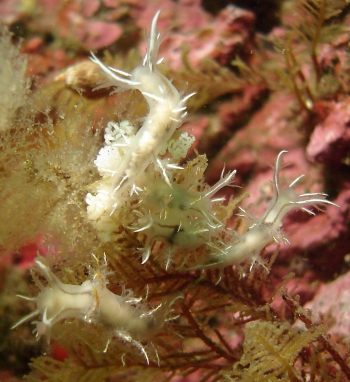
I believe these are Dendronotis diversicolor, and not D. albus seeing the position of the white stripe on the back. I am not satisfied with the quality of these photos but offer them as they may provide some help for others in identifying the eggs of Dendronotus diversicolor. It was stunning to find huge numbers of this species on sea fir (Abietinaria) at this depth. These 3 images were taken within a 1 square foot area. May 21, 2007 - they are still at it in the same location.
Locality: North East Pearse, 78 feet, British Columbia, Canada, Pacific Ocean, 28 April 2007, mud bottom. Length: 3 cm. Photographer: Jackie Hildering.
Jackie Hildering
earthlingenterprises@telus.net

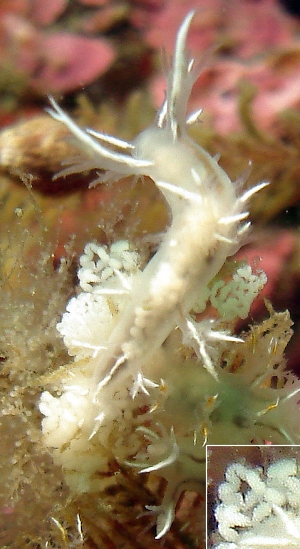
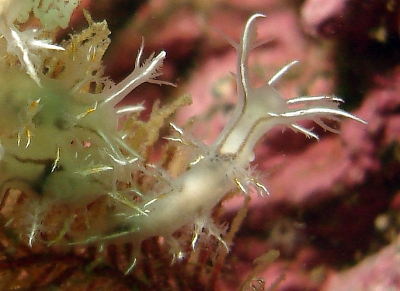
Hi Jackie,
The validity of Dendronotus diversicolor has been in question for some time and is currently being studied by a student of Dr. Angel Valdes. As suggested elsewhere on the Forum [message #16223 ], let's not use the name D. diversicolor, until matters are resolved. Again, I believe your photo contains the eggs of two differnt species. The tight mass (not sure what species laid it) in the middle left photo is quite different from the loose ones in your photo that I believe are those of the D. albus.
Hope this helps,
Dave Behrens
Dendronotus albus - new record from Korea
April 6, 2006
From: Dong Bum Koh
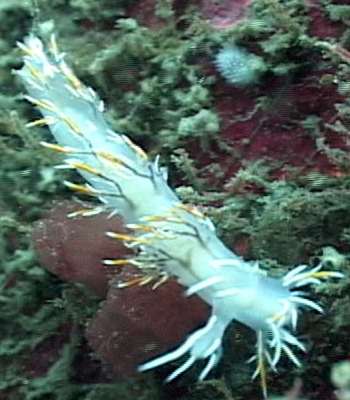
Dear Bill,
Here is a photo what I think of Dendronotus albus Macfarland,1966 or D. diversicolor? from South Korea. The photo was captured from video therefore image is not clear.
Locality: Gwang Won province. (E 129° N 37°7')., -15m, Korea, East Sea (cold sea), April 2006, --. Length: Approx. 40mm. Photographer: Tae Ho Cho.
Best regards,
Dong Bum Koh
drkoh@seasee.co.kr
D.B.Koh, 2006 (Apr 6) Dendronotus albus - new record from Korea. [Message in] Sea Slug Forum. Australian Museum, Sydney. Available from http://www.seaslugforum.net/find/16223Hi Koh,
Well another North Eastern Pacific species is recorded from Korea. Very good. Let's call this Dendronotus albus MacFarland, 1966, as D. diversicolor is in question and needs further study.
As coincidence would have it I have moved to the same small town where Gordon Robilliard (the biologist who described D. diversicolor) lives (Gig Harbor, Washington) and at lunch a few weeks back, Gordy told me he is no longer sure the species are separate having seen many hundreds of specimens having color variations that fill the gap between the two species. With this in mind, Gordy suggests, that for now, we use D. albus.
Best wishes,
Dave Behrens
Two colour forms of Dendronotus albus?
October 15, 2005
From: Dr. Steve Lonhart
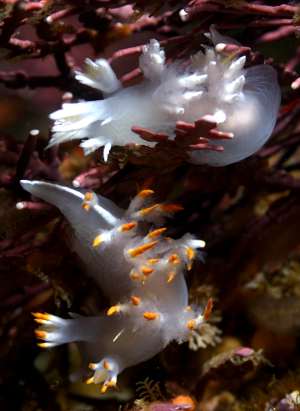
Dear Bill,
I am sending a shot of two slugs I believe are both Dendronotus albus. They were found next to each other, and look similar to the pair photographed by another contributor from the Channel Islands.
Locality: Stillwater Cove, Pebble Beach, California, USA. Depth: 45 ft. Length: 20 mm.16 September 2005. Shale reef. Photographer: Steve Lonhart
At first I thought the white individual might be Dendronotus dalli, but that seems unlikely given the lower number of cerata and the known range of D. dalli. Just thought I'd ask, though, in case it was an odd range extension.
Cheers,
Steve
lonhart@biology.ucsc.edu
Lonhart, S.I., 2005 (Oct 15) Two colour forms of Dendronotus albus?. [Message in] Sea Slug Forum. Australian Museum, Sydney. Available from http://www.seaslugforum.net/find/14853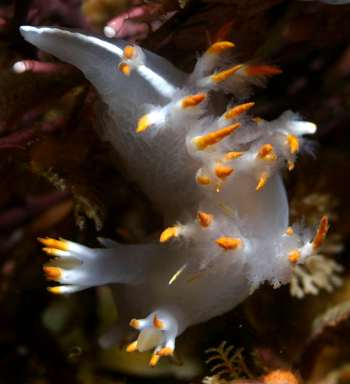
Dear Steve,
I'm pretty sure you are right but as the photo doesn't show if the white one has the characteristic white line down the 'tail' I can't be 100% sure
Best wishes,
Bill Rudman
Colour forms of Dendronotus albus
May 16, 2005
From: Jim Lyle
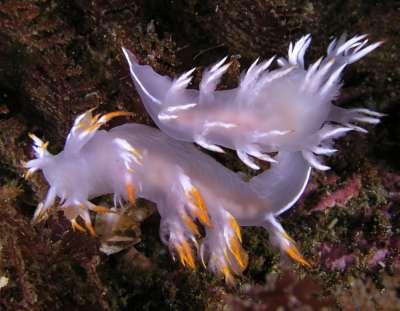
Here is a picture of a pair of Dendronotus albus from the Northern Channel Islands of California, showing slightly different color patterns - one has little coloring on the cerata.
Locality: San Miguel Island, California, USA. Depth: 20 meters. Length: 24 mm. 06 May 2005. Rocky reef. Photographer: Jim Lyle
Jim Lyle
jlyle@scubadiving.com

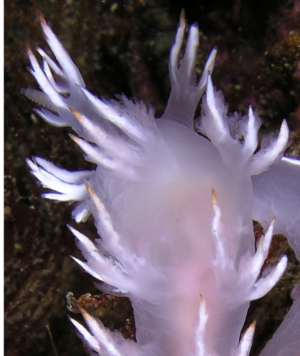
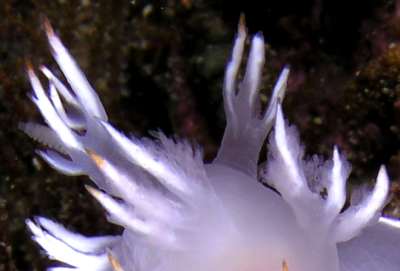
Dear Jim,
Nice to see an almost white form together with an orange-tipped form. I have included a close-up alongside as it shows the gills quite well
Best wishes,
Bill Rudman
Dendronotus albus from California
August 11, 2004
From: Bruce Wight

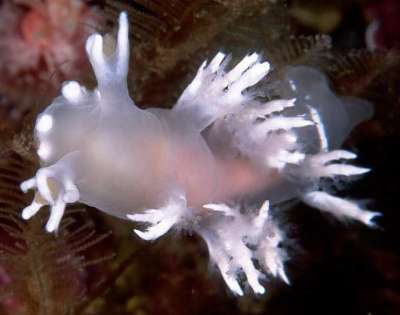
Dear Bill,
Here are photos of two colour forms of Dendronotus albus I photographed at San Miguel
Island [Channel Ids, California] in July 2004.
Bruce Wight.
bruce.c.wight@boeing.com
Wight, B.C., 2004 (Aug 11) Dendronotus albus from California. [Message in] Sea Slug Forum. Australian Museum, Sydney. Available from http://www.seaslugforum.net/find/12719Thanks Bruce,
I am not an expert on these animals but I wonder if they could be Dendronotus diversicolor? They both seem to have no more than 4 pairs of cerata. Any comments welcome.
Bill Rudman
Food of Dendronotus albus
September 16, 2003
From: Ken Ashman
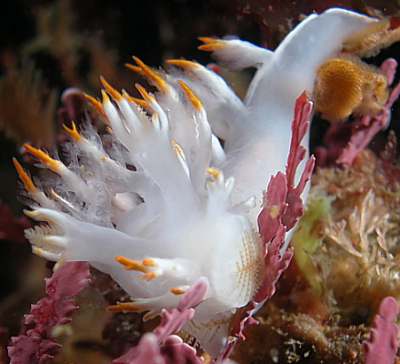
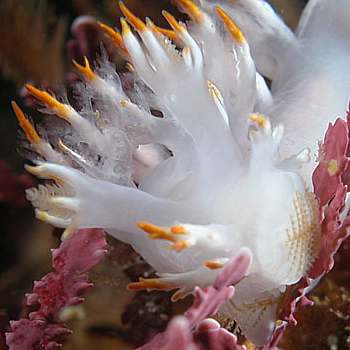
Can you reccomend a good reference for Pacific opisthobranchs covering the Californian coast?
This Dendronotus albus is feeding on a hydroid. I noticed the color of the cerata and processes mirror the hydroid's - is there a correlation? I'd love to have a resource I could take on dive trips where I could look up information along these lines re behaviors and habits of branchs...
I own David Behrens' fine photo-guide, but I'm wanting addittional references to answer these deeper questions.
Ken Ashman
ken@cadigitaldiving.com
Ashman, K., 2003 (Sep 16) Food of Dendronotus albus. [Message in] Sea Slug Forum. Australian Museum, Sydney. Available from http://www.seaslugforum.net/find/10969Dear Ken,
Thanks for the photo. Concerning a book, I was going to mention Dave Behren's book, but if you are looking for more in depth information on Californian opisthobranchs then you will need to go back to the scientific literature, for as far as I know there is nothing in between. I am afraid that although there are books such as you envisage for many vertebrate groups, such as birds, mammals, reptiles etc, and possibly butterflies amongst the invertebrates, there are not similar books for most invertebrate groups. One major reason for this is that we still don't know most things about most invertebrate species. Although we have a general understanding of the biology of many families, when we get down to individual species, we are pretty clueless. One reason for the Forum is to give interested amateurs the opportunity to help us learn more about the biology and natural history of opisthobranchs. By accumulating photos and observations on the Forum we are building up a store of information on many aspects of these animals' biology and natural history.
Concerniing your question about its colour pattern, we have to be careful correlating such things as the colour of parts of an animal and thegeneral aspects of this on a separate page. Some species do accumulate pigments from their food so that they are camouflaged. However I doubt that Dendronotus albus, which is essentially large and white, would gain much protection from potential prey by having orange-tipped processes, since the orange hydroid it seems to be eating is much smaller. But I could be wrong. One other point which complicates things is that Dendronotus albus is reported to eat a variety of hydroid species, not all of which are orange.
Any observations and questions are welcome. I can't guarantee to have an answer for them all, but with the help of other Forum participants, which should be able to give you a 'state of the art' answer - if we have one.
Best wishes,
Bill Rudman
Photos of Dendronotus albus
August 13, 2001
From: Clinton Bauder


Hi Bill,
Here are a couple of photos of Dendronotus albus from Carmel Bay, California, in about 20M of water. Hope they help sort things out. To be honest I'm still a little unclear on the subtleties between D. albus and D. diversicolor so I'm hoping someone more expert than myself will come through with some additional info.
Note that the second image shows 2 animals mating.
Clinton
gecko1@apple.com
Bauder, C., 2001 (Aug 13) Photos of Dendronotus albus. [Message in] Sea Slug Forum. Australian Museum, Sydney. Available from http://www.seaslugforum.net/find/5049Thanks Clinton,
Bill Rudman
